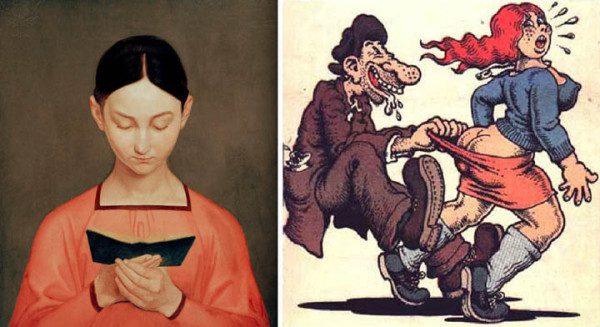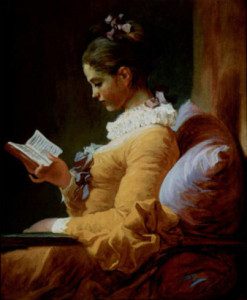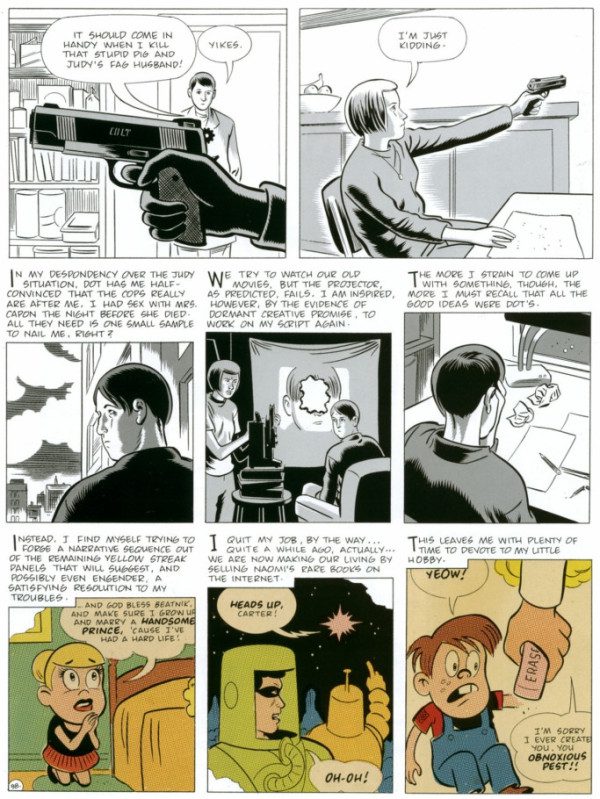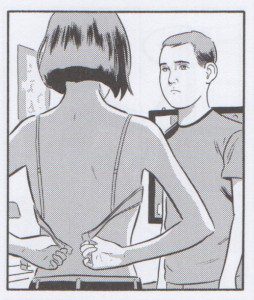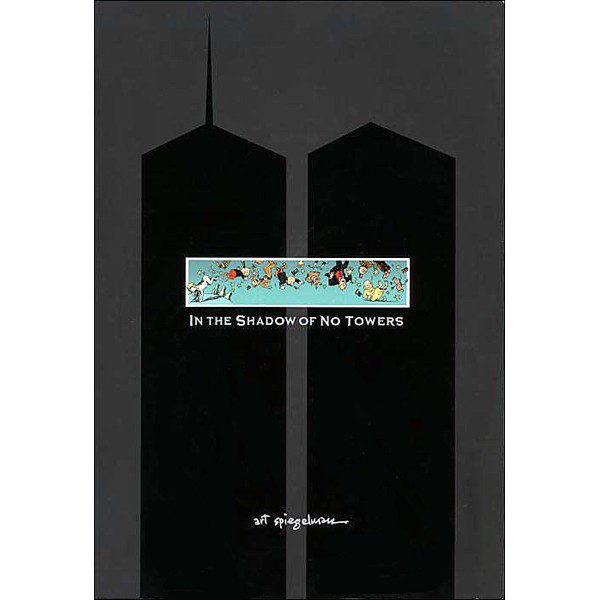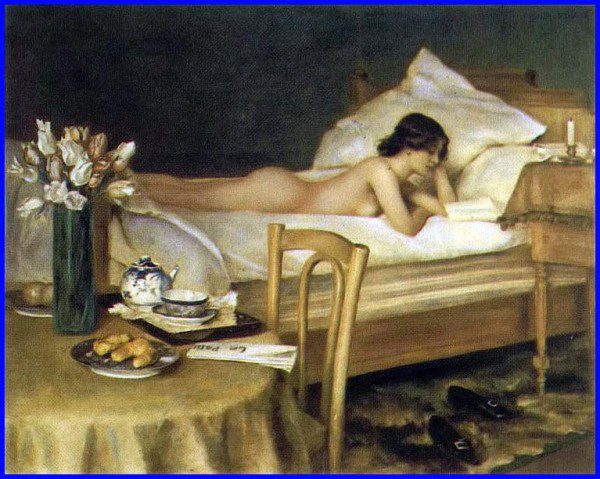The New York Comics & Picture-Story Symposium is a weekly forum for discussing the tradition and future of text/image work. Open to the public, it meets Monday nights 7-9 pm EST in New York City. Presentations vary weekly and include everything from historical topics and technical demonstrations to creators presenting their work. Check out upcoming meetings here.
This week’s presentation was unusual in that it introduced an academic tone to the comics symposium, thus highlighting the second part of its title. Michael Joseph, a rare book librarian at Rutgers University, and a frequent contributor to the discourse on children’s literature, presented his recently published article Seeing the Visible Book: How Graphic Novels Resist Reading in the Children’s Literature Association Quarterly (Winter 2012/Volume 37/Number 4).
The undercurrents of a childhood populated by 1960s DC and Marvel superheroes and later, an adolescence imprinted with underground comics steered his academic research of the theories of print and children’s literature into the realms of alternative comics, or graphic novels, which he refers to as a deprecated term. The likeness of the latter to the physical form of “real” books inspired him to map the ways in which the medium of comics employs this resemblance to undermine and critique the authority of books in the (western) cultural discourse. Joseph’s said his personal fascination with the medium also inspired the dark and gothic sounding subtitle of his lecture How Comics Resist the Ritual of Disembodiment and his dramatic performance of the article as well as the occasional couplet.
Joseph used contemporary comics to demonstrate his argument that the liminal existence of a graphic novel as an object on a bookshelf liberates it to illuminate the paradox in the elevated status of “real” books as disembodied objects of pure spiritual content. He quoted from two essays, “The Ideal Book” (1893), and “The Crystal Goblet, or Printing Should Be Invisible,” that helped shape the early-mid 20th century consensus that the design of a book should first and foremost facilitate its reader in transcending its own physicality. Joseph articulated the excerpts from “The Crystal Goblet” emphasizing his amusement with Wardes’ lack of self awareness while she expresses her disregard for “stunt typography” by the use of flowery language and pompous wine metaphors.
By laying peacefully in the palm of its reader, fourteen inches from his face and demanding no movement from his neck or eyes, a book induces specific codes of gesture which in turn affirm the reader of his proper place in society. In contrast, Joseph argues, by reading alternative comics, one is temporarily forced into the margins of his environment. One is in fact holding a form of weapon, or a sexual object and thereby is rejected from the organized environment of reading for which there are conventional gestures that surgically remove content into its own platonic existence.
Graphic novels constantly call the reader’s attention to their materiality. Joseph presented Ben Katchor’s The Cardboard Valise as an example of the object alluding to its own falsity. There is a cardboard flap attached to the cover of the book promising to take the reader on a journey. But this is merely a journey of the imagination. The object is unable to transform beyond its cardboard materiality. The act of reading is merely a brief childlike indulgence in make-belief. The true promise of the book only appears in its objective state.
Other examples Joseph brought up were the changing layouts of the page that demand the reader to constantly readjust the rhythm of his page turning. In other books, the eye of the reader is beckoned forward and backwards from the page with each scaling of the frames. The drawn typography is not only read, but looked at as part of the image. Large scale printing requires either heavy handed maneuvering or a delicate handling of the artifact. Finally, the images themselves inherently contain an entire social and political history and tear the reader away from the narrative. In this context, Joseph mentioned Daniel Clowes’s David Boring, which utilizes the name of his protagonist to remark on the reader’s need to divert from the narrative as a symptom of boredom. David Boring is drawn to chunky, colorful superhero comic panels and these interfere with the flow of the narrative by occupying equal space on the grid of the page.
The graphic novel is valuable to society as an object of transgression because it challenges the doctrine of text as truth. Curiously, Joseph later explains, the secondary goal of communicating a narrative may be enhanced by the constant diversion of the reader from its flow and renouncement of linearity. Many of the protagonists of graphic novels are glum, awkward members of society, created by artists working in a marginal medium, for members of society who may be awkward themselves. These could be adolescents tormented by teen angst, or adults somewhat closeted by the marginally legitimate/pornographic reputation of graphic novels they collect.
By relentlessly discouraging the reader from the actual story, the reader may experience the same alienation felt by the protagonists. Such is Joseph’s example of Adrian Tomine’s Summer Blonde. The use of Ben-Day dots as texture in the panels refers the reader towards the history of print and breaks his illusion that he is looking at real people through window frames rather than panels. Yet, these people become more real when the reader comes to sympathize with their alienation as fellow inhabitants of the medium. Moreover, the raw self-conscious gritty rendering of the characters in graphic novels reassures the readers of their own physical insecurities, thus reinforcing awkward coming-of-age narratives while reflecting the more abstract process of re-embodying the book form.
Next, Joseph analyzed the cover of Art Spiegelman’s In the Shadow of No Towers as an example of the important role alternative comics play not only in the criticism of society, but also of itself, as a medium. This monumental object defies almost every aspect of bookness. It’s unshelvable and almost unbearably heavy the cover is dark and almost unreadable. The layouts echo pamphlets, tabloids, magazines, centerfolds, pin -ups, and anything but books. The sombre dramatic image of the blackened twin towers, boldly alluding to religious icons of western traditions, is offensively interrupted by a cartoon strip. In this way the book admits to the ambiguity of its form and context and to the strength and weakness of the medium. Spiegelman uses this thematically in his design as reflection of the inability to re-institute harmony, reconcile or place blame in the post 9/11 world, by turning his book into a weapon against itself.
Joseph concluded his presentation with a series of images from art history depicting the act of reading, especially noting the nudity of the figures holding books in their hand in the privacy of their chambers but for the viewer’s gaze. However, the seemingly erotic caress of the book is not meant sexually, but rather as the oblivion of the self and the transcendence of both the book and the reader from their bodily state. We then watched a video demonstrating the notion of rebellion against the passive practice of reading its demand to sacrifice the self to conform with the text.
Q&A
The first question brought into discussion by the forum regarded the transition of books into the digital arena and whether this is consistent with the paradigm of the ideal transparent book, stripping it even more of its physical attributes. Joseph replied with an anecdote about his friend’s “Wall of Pride”, made up of the books he had collected as trophies of affirmation. Walls such as these don’t exist in a digital world and “a Kindle can’t lead you away from the ledge.”
Another question raised was whether the graphic novel has finally come into its own as a form, after its fans’ struggle to elevate it to the ranks of legitimate literature. Joseph noted that although there seems to be a wide acceptance nowadays of graphic novels as legitimate forms of literature, they are also more vulnerable to scrutiny by their refusal to follow the rules of the form. He also emphasized that by identifying themselves as comics and not demanding seriousness they retain there freedom to critique. Lastly, the relationship between picture books and graphic novels was discussed, focusing on the pedagogic notion that over a certain age, pictures should no longer be a part of the education process, and the need for adolescents to re-learn how to interact with text through graphically oriented narratives.
***
First image: (left) Reading Girl by Gustav Adolph Hennig (1797-1869), c. 1828 (oil on canvas) Museum der Bildenden Kuenste, Leipzig. (right) drawing by Robert Crumb.
Second image:”Young Girl Reading” Jean-Honoré Fragonard, oil on canvas, 31 15/16 x 25 1/2 in. 1770
Third image: “The Cardboard Valise”, Ben Katchor, Pantheon Books, 2011
Fourth image: “David Boring”, Daniel Clowes. Pantheon Books, 2000
Fifth image: from “Summer Blonde” Adrian Tomine, Drawn and Quaterly, 2003
Sixth image: “In the Shadow of No Towers” Art Spiegelman, Viking Adult, 2004
Seventh Image: “The Bookworm”, Hermann Fenner Behmer, oil on canvas, 1906
***
About the author: Keren Katz is the illustrating half of The Katz Sisters duo. She is also the half that is not fictitious. They are currently collaborating on the graphic novel “The Night Poetry Class in Room 1001”. You may check out more of her projects here and some of her books here.

